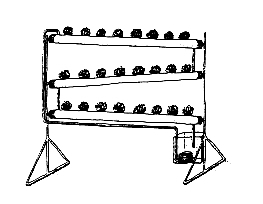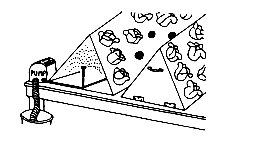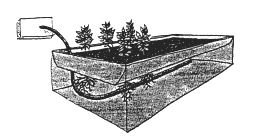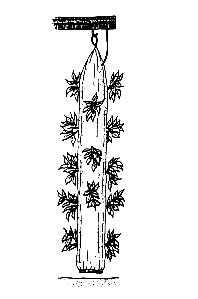Introduction
Hydroponics is often defined as "the cultivation of plants in
water." Research has since determined that many different aggregates or media
will support plant growth; therefore, the definition of hydroponics has been
broadened to read "the cultivation of plants without soil."
Growers all over the world are using hydroponic techniques due
to the lack of a large water supply or fertile farmland. Home gardeners have
used hydroponics on a smaller scale to grow fresh vegetables year round and to
grow plants in smaller spaces, such as an apartment or balcony. Greenhouses and
nurseries grow their plants in a soilless, peat- or bark-based growing mix. The
nutrients then are applied to the growing mix through the water supply.
Therefore, this is also a type of hydroponics.
Soilless gardening offers many advantages to the home
gardener. Since a sterile medium is used, there are no weeds to remove, and
soil-borne pests and diseases are minimized, if not eliminated completely.
Properly grown hydroponic plants also are healthier and more vigorous because
all of the necessary growth elements are readily available. The plants can
mature faster, yielding an earlier harvest of vegetable and flower crops.
Hydroponic gardens use less space since the roots do not have to spread out in
search of food and water. This small space requirement makes hydroponics ideal
for home gardeners, and it makes better use of greenhouse space. The big
advantage to hydroponics is the ability to automate the entire system with a
timer. Automation reduces the actual time it takes to maintain plant growth
requirements. Automation also provides flexibility to the gardener as one can be
gone for long periods of time without having to worry about watering the plants.
Hydroponics offers many advantages for commercial agriculture.
Cultivating plants without soil eliminates the need for vast farmland and allows
crops to be produced in greenhouses or even in the desert sands. Hydroponic
techniques also allow for precise water and nutrient application directly to the
roots of each plant. Water is reused in these systems and less is lost through
evaporation and run-off. Therefore, arid lands, such as deserts, can be
transformed into productive lands using limited amounts of water. Growing plants
hydroponically is not difficult if one understands the basic principles. As long
as plant growth requirements are met, there are numerous hydroponic systems that
can be used.
Return to Table of Contents
Plant Requirements
Whether a plant is grown in soil or a soilless medium, there
are many factors affecting plant growth and productivity. All plants require
nutrients, water, light, and air to grow. A plant grown in soil obtains
nutrients and water from the soil, when available. With hydroponics, because
water and nutrients are always available, the plant is never stressed. Sunlight
and air are readily available in an outdoor hydroponic system. However, for an
indoor system, one must provide an adequate light source and good air
circulation. Metal halide lamps, sodium vapor lamps, gro-lights, or fluorescent
lights used in conjunction with incandescent light bulbs provide adequate light.
Plant roots must have oxygen available to keep them alive. Healthy roots (which
are white in color) are responsible for the uptake of all nutrients for the
plant. If the roots die, it is impossible for the plant to survive, even if the
plant growth requirements are met. Air circulation around leaves is important
since it mixes the air and allows the plant to draw out the carbon dioxide
necessary to carry on photosynthesis. Air circulation also helps prevent fungal
diseases caused by moist, stagnant conditions. Indoor units often have a small
fan to circulate the surrounding air.
Return to Table of Contents
Nutrient Solution
The nutrient solution is the most important factor in the
success or failure of a hydroponic system. Most fertilizers commonly available
in garden centers do not contain all of the 13 elements necessary for plant
growth because the growing media usually provides many of them. Hydroponic
plants receive nutrients from a different source; so it is necessary to use a
fertilizer formulated for hydroponic systems. Hydroponic fertilizers are
available from many mail order companies and a few specialty garden centers. It
is important to follow the dilution rate recommended on the label and to test
the solution to be sure that the pH is between 5 and 6. Simple pH test kits and
pH modifiers are available wherever fish supplies are sold.
Depending on the stage of plant development, some elements in
the nutrient solution will be depleted more quickly than others. Because of
this, it is important to change the nutrient solution every two weeks. The old
solution can be used to water other houseplants or outdoor plants. Also, make
sure that the nutrient solution is kept at the original volume. As water
evaporates from the nutrient solution, the fertilizer becomes more concentrated
and can burn plant roots. Add water only and not more fertilizer to raise the
nutrient solution back to its original volume.
Return to Table of Contents
Water culture systems include the nutrient film technique,
aeroponics, and the aeration method.
The nutrient film technique (fig.1 shown below), uses a
plastic trough or tube as the container through which a constant, thin film of
nutrient solution flows. Plants are suspended through holes in the top of the
trough. The trough is gently sloped so gravity pulls the solution back to the
nutrient reservoir. There are many variations of this system, making it the most
popular for the home gardener.
Aeroponics (fig.2 shown below, is
the growing of plants in a container in which the roots are suspended in a
nutrient mist rather than in a solution. The most popular container for
aeroponics is an enclosed A-frame constructed of styrofoam boards. The plants
are placed in holes along the sloped sides of the frame. The nutrient mist is
delivered to the roots by a vaporizer or by special attachments available with
drip irrigation kits. The mist clings to the roots. Any excess runs down the
inside of the frame, is collected at the bottom, and is recycled back to the
nutrient reservoir.
The aeration method (fig.3 shown below)), one of the
first systems to be developed, uses an aquarium air pump to bubble oxygen to the
roots of plants immersed in the nutrient solution. Plants are suspended 1 inch
above the solution by a 2-inch-deep mesh tray that is set into the container by
placing the lip of the tray over the container's edge. A layer of inert
material, such as gravel, clay pebbles, or vermiculite, is placed in the tray to
provide stability for the plants while allowing the roots to grow down into the
nutrient solution.



Fig.
1 Fig.
2 Fig. 3
Return to Table of Contents
Aggregate systems use some form of inert material to support
and surround plant roots. The most common materials used are rockwool, clay
pebbles, gravel, perlite, vermiculite, sand, or foam chips. The media provides
plant support, allows good oxygen penetration to the roots, yet retains a thin
layer of nutrients and water around the roots. One of the most common systems
using an aggregate media is the flood and drain method (fig.4 shown
below). A water-holding container, such as a plastic dish pan, is filled with
the aggregate and plants. The container is flooded periodically with the
nutrient solution. The solution is drained back into the nutrient reservoir by
opening a valve at the bottom of the container. During each cycle, the roots
should be submerged in the solution for no more than 20 to 30 minutes.
Another common aggregate system is the trickle feed method
(fig.5 shown below)). The nutrient solution is continuously pumped from the
reservoir through a 1/2-inch irrigation tube that branches into a number of
1/8-inch tubes. These smaller tubes deliver the solution to the containers. Any
excess solution is collected at the base of each container and returned to the
nutrient reservoir.
A modification of the trickle feed method is called tube
culture (fig.6 shown below)). A 4- to 6-inch plastic tube or bag is filled
with a lightweight aggregate. Holes are made on all sides of the container for
the plants. The tube is hung vertically, and an irrigation tube is positioned at
the top of the container. The nutrient solution seeps through the container and
may or may not be recycled when it reaches the bottom.

Fig.
4 Fig.
5 Fig. 6
Return to Table of Contents
Summary
Several developments in the past few years have made
hydroponic gardening easier for the home gardener. Newer systems are simpler to
set up and operate. An increase in suppliers of hydroponic products means
equipment and special fertilizers are more easily obtained by the home gardener.
The use of lightweight plastics in the newer systems makes hydroponics less
expensive and a better investment than older systems that used heavy, concrete
benches.
Hydroponic systems are available in a variety of sizes and
prices. Kits are available from many suppliers, and some hydroponic systems can
be built easily at home from materials found at hardware stores and fish supply
stores. Numerous hydroponic and soilless gardening books can be found in local
libraries and bookstores. Information also is available through the Hydroponic
Society of America, P.O. Box 6067, Concord, CA 94524, (415)682-4193.
Return to Table of Contents
![]() Gardeners' Corner
Kids'
Garden
Sustainable Garden
Contact Us
Gardeners' Corner
Kids'
Garden
Sustainable Garden
Contact Us![]()





